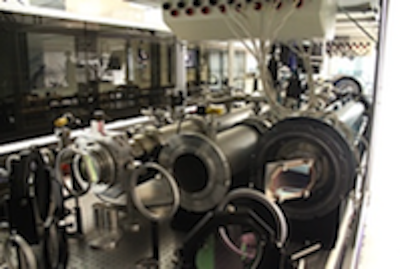The PHOENIX LASER LABORATORY hosts three lasers with different energy, pulse shape, and repetition rate parameters: PHOENIX, RAPTOR, and PEENING . Each is employed in creating laboratory plasmas with parameters tuned to the research goal or for diagnostics. In our ongoing project, the study of collisionless shocks can be accomplished by shining a focused energetic laser pulse onto a solid target surrounded by an ambient low-density, magnetized plasma. In these experiments, the laser works in tandem with the Large Plasma Device (LAPD) in a quite unique combination of facilities. With proper scaling, this scenario mimics similar events occuring in space that can be accurately reproduce for detailed studies.
PHOENIX Laser
PHOENIX is a Nd: silicate glass pulsed laser with five amplification stages, and a 30 J total output energy capability. It became first operational in 2005 and in the following years it went through a series of transformations and upgrades: a re-designed architecture to include a double-pass amplification stage, and an improved relay-imaging throughout the system, as well as an automized input energy control.
- Wavelength: 1064 nm
- Pulse Length: 5 ns (FWHM)
- Output Energy: 1-30 J
- Repetition Rate: 5 min.


RAPTOR Laser
RAPTOR is a Nd:glass laser build in 2010, with parts from the NOVA laser from Lawrence Livermore National Laboratory. It is designed around two disk amplifiers (10 cm and 15 cm disk size), with four passes through the 10 cm amplifier and one pass through the 15 cm output amplification stage. The total energy capability of the laser system is 1 kJ, in 1-100 ns pulses, with a total gain of 1000, at a shot rate of 45 min. (due to air-cooling the amplifiers). The variable pulse shape is obtained by a programmable electro-optic modulator in the front-end of the system.
The pulse power powering Raptor's flashlamps stores up to 500 kJ of energy when charged (shown in the image on the right).
- Wavelength: 1053 nm
- Pulse Length: 1 ns - 100 ns (variable)
- Output Energy: 300 J (max. 1 kJ)
- Repetition Rate: 45 min.


PEENING Laser
PEENING is a Nd:phosphate glass laser commissioned in 2012, which was designed by a team of laser engineers and physicists from Lawrence livermore National Laboratory. With an output energy of 20 J at a repetition rate of 1-6 Hz, this laser system propulses experiments on elaborated levels of fast, accurate, and detailed data aquisition. The energy is build-up in an 8-pass circuit, through an amplifying glass slab designed to ensure rapid heat removal by turbulent water flow. The thermal birefringence effects are compensated by the use of a phase-conjugation mechanism which corrects the beam from abberations by wavefront reversal. The result is a diffraction-limited beam at high repetition rate.
- Wavelength: 1053 nm
- Output Energy: max. 20 kJ
- Pulse Length: 15 ns
- Shot Frequency: 1-6 Hz

Laser Command and Control
The Phoenix Laser Laboratory is controlled and monitored by the custom-built Phoenix System Terminal (PST) application (built by Derek Schaeffer, and designed with a friendly user interface after a Star Trek fashion). The PST combines a networked graphical user interface with a scalable hardware abstraction layer, using an object-oriented plugin architecture written entirely in LabVIEW. As a result, the PST can control and monitor from anywhere in the lab over 1000 I/O points in real-time, including the lasers, their pulsed power systems and firing algorithms, dozens of diagnostics, and interlock safety systems.

Target chambers
Some of the experiments or testing of devices, diagnostics, etc. can be performed in either of our two target chambers with vacuum capabilities in the 10-6 torr range:
- The "PI" chamber (left image): a 1 m diameter stainless steel vacuum vessel with external magnetic coils to create DC fields of 100 Gauss.
- The "SPHERE" chamber (right image): a 40 cm diameter vacuum vessel with ports all around and Helmholtz coils mounted inside providing pulsed magnetic fields of up to 800 Gauss: a small chamber with a Death Star attitude 😎!


